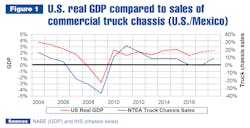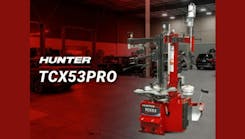Work truck and equipment sales see second quarter increase, NTEA data finds
Report by Steve Latin-Kasper, NTEA Director of Market Data & Research
U.S. EconomyWork truck and equipment sales increased in the second quarter, along with the U.S. economy. After registering a growth rate of only 1.2 percent in the first quarter, the economy jumped to a rate of 3.0 percent in the second. Primary drivers of faster gross domestic product (GDP) growth were upturns in private inventory investment and federal government spending, as well as an acceleration in personal consumption expenditures (PCE). However, declines in residential fixed investment and state and local government spending prevented an even higher growth rate.
In the second quarter, PCE didn’t just grow — it climbed at a faster rate than in the first quarter. This indicates improvements in consumer confidence are leading to more spending, which will have a positive impact on the rest of the economy. On the other hand, declines in residential fixed investment and state/local government spending could be problematic for many work truck industry companies.
Housing starts is a primary component of residential fixed investment, but unlike the larger measure, starts are not decreasing — they ascended at a 7.3 percent rate in the first quarter. Growth continued in the second quarter, but the rate fell to 1.5 percent, which is partially attributed to the labor shortage. Contractors can’t build new homes without crews. Another issue is, as of the second quarter, house prices have risen high enough to become a limiting factor as well.
While total state and local government expenditures fell in the second quarter, equipment expenditures remained up. The decline in total expenditures was the result of a large drop in construction. This may have a negative effect on equipment expenditures, but as shown in Figure 2 (above right), they are unlikely to decline this year. Since they tend to follow turns in the truck sales cycle, the rate of growth of expenditures will likely follow truck sales back up in the first half of 2018.
As we close out the third quarter, unemployment and inflation rates remain at solid levels. The misery index (sum of both rates) was just 6 as of July, which is a low level and usually an indication economic growth will continue. As a result, Federal Reserve should continue raising interest rates. We will likely see at least one increase of .25 percentage points before the end of 2017 (some economists predict rates will rise .50 percentage points).
Work truck industry
U.S./Mexico commercial truck chassis sales rose 4.7 percent in the second quarter — a big improvement from the –2.2 percent decline in the first. The cutaway chassis cab segment was primarily responsible for the boost. After declining 8.1 percent in the first quarter, as compared to the first quarter of 2016, sales rose 5.9 percent in the second.
Total U.S./Mexico commercial truck chassis sales climbed about 12,000 units on a quarter-to-quarter basis. The jump in cutaway represented 7,000 of those units, and conventional and low cab-over-engine (LCOE) sales increased 4,000 and 2,000 units, respectively. Strip chassis sales decreased roughly 2,000 units from the first to the second quarter.
Since cutaway cabs are primarily used in Classes 2–5, it’s not surprising there was substantial growth in most of those segments. Second quarter sales of Class 3–5 chassis grew at 7.6, 11.6, and 16.8 percent rates, respectively. Class 2 sales ran counter to the trend — rising 11.5 percent in the first quarter but falling 6.4 percent in the second.
Second-quarter growth rates were slower in Classes 6–8. Class 6 sales declined at a 12.2 percent rate, while Classes 7 and 8 rose at 5.8 and 1.5 percent rates, respectively. In both of those classes, sales dropped in the first quarter. Tractor sales (Classes 7–8) fell again, at a rate of 9.2 percent, but it was a vast improvement over the 28.8 percent decrease registered in the first quarter.
The commercial van segment deviated from trend in the second quarter. For the past three years, high roof-height sales grew faster than standard roof-height. In fact, standard have been trending down. In the second quarter of this year, though, that changed. On a same-quarter/previous-year basis, standard roof-height sales were down 7.3 percent in the first quarter, but increased 1.3 percent in the second. On a quarter-to-quarter basis, sales grew at a 15.2 percent rate.
In the high roof-height sector, sales fell 1.7 percent in the second quarter as compared to 2016, after rising 30 percent in the first. The longer-term trend did not likely change in the second quarter; the more plausible reason may be attributed to production issues causing shipments to fall behind demand.
In Canada, commercial truck chassis sales rose 20.3 percent in the second quarter, primarily as a result of almost 50 percent growth in June. This pushed the rate of growth for the year through June up to 9.3 percent — well ahead of the rate registered in the U.S./Mexico market.
Conventional cab and LCOE sales climbed 36.3 and 25.2 percent, respectively, in the second quarter as compared to same timeframe last year. Strip and cutaway chassis sales fell. By weight class, most of the second quarter growth was registered in Classes 3, 5 and 6, which rose at rates of 46.5, 78.6 and 205.0 percent, respectively. Sales also jumped in Classes 2 and 7, but fell in Classes 4 and 8.
Tractor sales kept dropping in the second quarter, but at a decelerating rate. Commercial van sales grew just 0.1 percent in the second quarter after increasing more than 25 percent in the first.
Metals and energy prices
Steel prices continued rising in July, but at a decelerating rate. For the year, hot-rolled steel sheet/strip prices were up 11.7 percent, but only 5.4 percent for the most recent quarter. Cold-rolled steel sheet/strip prices were up 16.9 percent for the year and 3.3 percent in the most recent quarter. As shown in Figure 4, hot- and cold-rolled steel sheet/strip prices are approaching a cyclical peak.
Prices for both will likely continue rising through the end of the year, but are expected to stabilize in 2018. In fact, some industry analysts predict steel prices will fall slightly next year, as there is still substantial excess capacity in the global steel industry. In addition, factors such as China needing to account for low inventories of steel products in the first quarter of 2017, won’t impact the market in 2018. However, global economic growth may accelerate next since the European Union, U.S., China and India are all expected to grow faster. This will put upward pressure on prices. The question is, will there be enough capacity available to keep pace with demand? As of now, that appears to be the case.
Aluminum prices seem to be approaching a cyclical peak faster than steel as of July. Sheet prices were up 7.1 percent for the year, but fell 2.8 percent in the most recent quarter. As is true in the steel industry, there is overcapacity in the aluminum market. The global automotive industry is still anticipated to increase its demand for aluminum in 2018, but at a slower pace. Existing capacity should be more than enough to keep up with demand next year. As noted, though, this could change with faster global economic growth.
In the energy market, the price of oil revolved in a tight range between $46 and $55 per barrel for most of the year. After rising steadily through 2016, U.S. diesel prices stabilized in the first quarter of 2017, and fell slightly in the second quarter. One of the economic impacts of Hurricane Harvey will be a jump in diesel and gasoline prices, but it will be temporary. However, a 4.3 percent unemployment rate and continued job creation in a growing U.S. economy is putting more people on the road driving more miles. By the fourth quarter, increasing demand may simply replace the upward pressure on prices created by Harvey. Diesel
Leading indicators
The construction industry was affected by the tight labor market (as were most other U.S. industries), and as a result, the number of new homes being built is well behind forecast. In the first quarter, housing starts rose at a 7.3 percent rate, which decelerated to 1.5 percent in the second quarter. For the year through July, housing starts have grown 2.4 percent. The forecast for 2017 was 10 percent.
Demand from millennials in the process of forming families is high, but the labor shortage is preventing supply from keeping pace. This isn’t just putting upward pressure on new home prices — it’s also affecting existing home prices. This increase has raced far ahead of income growth for the past three years, leading to the current situation in which people who want to own their homes are forced to continue renting. This doesn’t put downward pressure on home prices — it’s merely a shift from single family to multifamily housing. Prices won’t stabilize until supply catches up with demand, which probably won’t occur until the next recession.
Most economists are not predicting recession in 2018 or 2019, and based on the yield curve (shown in Figure 6), they are correct. Clearly, the yield curve is not trending in the right direction. It will likely reach the zero line and invert sometime around the end of 2018 on current trend, which means the next recession would start around the fourth quarter of 2019. However, the yield curve isn’t anticipated to continue on current trend for the next year or two. Recession in 2020 or later is more probable.
What does this mean for the work truck industry? Continued growth for the next two years — probably at an average rate of about 5 percent — is likely. The labor shortage may get worse before it gets better, which means companies that know how to get the most productivity out of their existing workforce will be well positioned to take advantage of opportunities arising between now and 2020.
For more industry market data, visit ntea.com/marketdata.


